The old-fashioned way of getting the right keywords in translated content used to be: 1) do the website translation; 2) do keyword research; 3) get the keywords into the translated content. But, there’s a catch – this is the most complicated and costly method of localizing ‘SEO content.’
Today I am presenting a totally different, yet very simple way to get the right keywords into your localized content – just by following a simple workflow and using SEMrush data tools!
And the best thing is, once you manage to do the basics, you can easily apply the same workflow to any remaining language or country versions.
Step #1: Prepare the Source Text for SEO Localization
Make sure keyword density is below 2.5% Make sure the copy contains a wide variety of keywords: perform a WDF*IDF analysis to ensure optimal distribution of keywords and topics Make sure the copy contains all of your product keywords and terms related to your business Internationalize the content: make sure the text does not contain locally-relevant information or cultural connotationsStep #2: Create a Source-Language Termbase
Go through your source text (typically English) and extract key terms
Product keywords with all their equivalents Brand keywords Informational keywords, product features (adjectives, nouns), issues (verbs, nouns), solutions (verbs, nouns), FAQs Verbs that characterize your business or product Transactional keywords (e.g. buy online, online shop, discount etc.)List these terms and create a termbase.

Categorize the keywords you have found (parts of speech, context) so that you can connect them to the correct equivalents later.
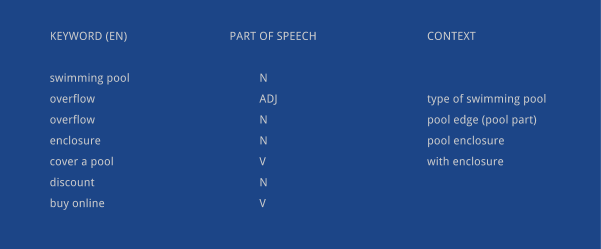
Step #3: Perform Multidimensional Keyword Research
Add relevant topics in the target language to the source-language terms:
Further topics connected to your product (do this with a native speaker) Related keywords feature (SEMrush) Transliteration or transcription of keywords Frequent misspellings For more tips refer to this piece: 7 Tips For Cross-Cultural Keyword Research
Finalize the list of suggestions.
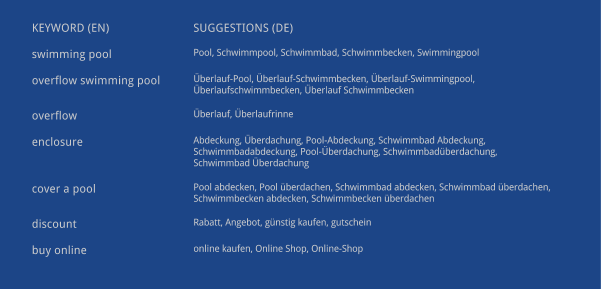
Use Keyword Tool or ClickStream (here’s a short guide) to analyze the search volumes. This will also act as a useful tool for any further research and for finding more terms. Create a very long list of keywords and sort them according to search volume.

Step #4: Pair Keywords and Phrases; Create a Bilingual Translation Glossary
Ask a native speaker to find a match between the highest number of source terms with the newly found terms. Tell them to choose the most searched-for term if there are multiple options.
If there is a partial match (a so-called ‘fuzzy match’), ask them to divide the target keyword into multiple words, and then match.
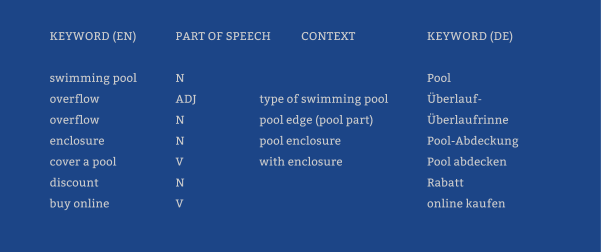
If there is no match, leave the target language cell blank. You can use these later to identify additional keyword topics in the target language.
Don’t try to find a ‘perfect fit.’ Since two languages represent two very different cultural environments, the nearest equivalent will be a very free translation of the original term. That’s okay. The translator can later re-write the whole sentence in order for the term to fit in.
Step #5: Find a Translator with CAT Tools
CAT (Computer Assisted Translation) tools allow translators to use a termbase in real time during translation. They literally offer the term from the termbase every time it occurs in the source text. They also have a built-in Q&A functionality that checks the correct usage of the term according to the termbase.
Where can you find a translator with a CAT tool?
One of the largest human translator directories is proz.com. You can specify your CAT tool requirements in your inquiry. Also, I recommend you specify the file format of the termbase you have, so that the translators can assess how easy or difficult it will be to import the file into the CAT tool they are using.
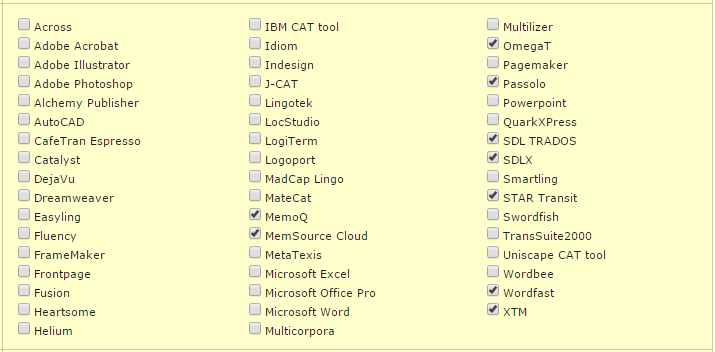
Step #6: Create an Assignment for the Proofreader
Once you have received the translation with the key terms in it, you can create an assignment for a proofreader to make sure the style is good, whilst retaining all the key terms in the translation. Provide the proofreader with the original text, but do insist on keeping the terminology unchanged (but open to suggestions).
The assignment could sound like the following:
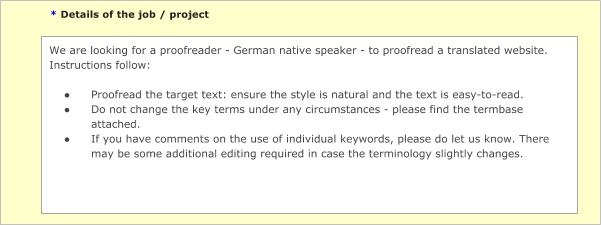
Important note: the proofreader’s job is not to revise the translation for accuracy. Their only job is to make sure the style of the target text is natural and fluent, whilst keeping the key terms (keywords) unchanged.
Step #7: Perform a Final SEO Tune-Up
Edit the target text and add some unpaired keywords from the file, where appropriate Localize the NAP information Localize the schema markup Localize or internationalize brand content - see this piece for further information: Web Localization Strategy: How to Localize Content Like a MarketerRinse and repeat. Good luck!
Have you tried a different approach of making your localized content SEO-friendly? Let me know in the comments!
Martin Kůra is an International SEO Strategist. You can visit his personal website.
Innovative SEO services
SEO is a patience game; no secret there. We`ll work with you to develop a Search strategy focused on producing increased traffic rankings in as early as 3-months.
A proven Allinclusive. SEO services for measuring, executing, and optimizing for Search Engine success. We say what we do and do what we say.
Our company as Semrush Agency Partner has designed a search engine optimization service that is both ethical and result-driven. We use the latest tools, strategies, and trends to help you move up in the search engines for the right keywords to get noticed by the right audience.
Today, you can schedule a Discovery call with us about your company needs.
Source:




![How To Create a Strategic Dashboard in Excel Using Semrush Data [Excel Template Included]](https://new.allinclusive.agency/uploads/images/how-to-create-a-strategic-dashboard-in-excel-using-semrush-data-excel-template-included.svg)
